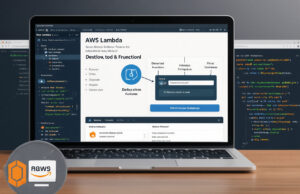AWS Elastic Block Storage delivers the reliable, high-performance storage your cloud applications need to run smoothly. This guide is designed for developers, system administrators, and IT professionals who want to master EBS and get the most out of their AWS storage solutions.
EBS isn’t just another storage option—it’s the backbone that keeps your EC2 instances running fast and your data safe. You’ll discover how different EBS volume types can match your specific performance requirements, from general-purpose workloads to high-IOPS database operations. We’ll also dive into AWS EBS best practices that can dramatically improve your cloud storage performance while keeping costs under control.
By the end of this deep-dive, you’ll know exactly how to choose the right volume type for your needs and implement EBS optimization strategies that boost both speed and efficiency.
Understanding AWS EBS Fundamentals
What Makes EBS Different from Traditional Storage Solutions
AWS Elastic Block Storage revolutionizes cloud storage by providing persistent, high-performance block-level storage that survives EC2 instance termination. Unlike traditional physical storage systems that tie data directly to hardware, EBS volumes exist independently and can attach to any EC2 instance within the same Availability Zone. This separation means your data stays safe even when instances fail or get replaced. EBS automatically replicates data within its Availability Zone, eliminating the single points of failure common in traditional storage. The service offers instant provisioning and dynamic resizing capabilities that physical storage simply can’t match, allowing businesses to scale storage capacity on-demand without downtime or complex migration processes.
Key Components and Architecture That Power EBS
EBS operates through a robust architecture built on three core components: volumes, snapshots, and encryption services. Volumes serve as the primary storage units that attach to EC2 instances via high-speed network connections rather than physical cables. The underlying infrastructure uses distributed storage clusters with automatic data replication across multiple servers within an Availability Zone. Snapshots provide point-in-time backups stored in Amazon S3, enabling disaster recovery and volume cloning across different regions. The architecture includes dedicated bandwidth allocation between EBS and EC2, ensuring consistent performance regardless of network traffic. Advanced features like Multi-Attach allow specific volume types to connect to multiple instances simultaneously, while built-in encryption protects data both at rest and in transit.
How EBS Integrates Seamlessly with EC2 Instances
EBS volumes attach to EC2 instances through the AWS hypervisor layer, appearing as standard block devices to the operating system. This integration happens at the kernel level, making EBS volumes indistinguishable from local drives to applications and users. The attachment process takes seconds and requires no instance reboots, enabling hot-swapping of storage resources. Instance metadata services automatically expose volume information, allowing applications to discover and configure storage dynamically. EBS-optimized instances provide dedicated bandwidth channels that prevent storage traffic from competing with network communications. The tight integration extends to AWS services like CloudWatch for monitoring, IAM for access control, and AWS Backup for automated protection, creating a comprehensive storage ecosystem that works seamlessly with your cloud infrastructure.
Core Benefits That Make EBS Essential for Cloud Operations
Persistent Data Storage That Survives Instance Failures
AWS Elastic Block Storage keeps your data safe even when EC2 instances crash or terminate unexpectedly. Unlike instance store volumes that vanish with the instance, EBS volumes exist independently and automatically detach during failures, preserving all your critical information. You can quickly reattach these volumes to new instances, getting back online without losing a single file. This persistent storage capability makes EBS essential for production workloads where data loss isn’t an option.
Flexible Scaling Without Downtime or Data Loss
EBS lets you expand storage capacity and boost performance while your applications keep running. You can increase volume size from gigabytes to terabytes instantly, and even switch between volume types when your needs change. The elastic nature means you pay only for what you use, scaling up during peak periods and down during quiet times. This flexibility eliminates the traditional storage planning headaches that come with physical hardware deployments.
High Availability and Automatic Replication Protection
Every EBS volume automatically replicates within its Availability Zone, protecting against hardware failures and ensuring 99.999% availability. This built-in redundancy means your data stays accessible even when individual drives fail. AWS handles all the complex replication behind the scenes, so you don’t need to worry about setting up backup systems or managing failover processes. Your applications get enterprise-grade reliability without the enterprise-level complexity.
Cost-Effective Storage Management for Any Budget
EBS offers multiple pricing tiers that match different performance and budget requirements perfectly. General Purpose volumes provide excellent value for most workloads, while Cold HDD options dramatically reduce costs for infrequently accessed data. You can optimize spending by right-sizing volumes and using features like EBS snapshots for efficient backups. The pay-as-you-go model means startups and enterprises alike can access professional-grade AWS storage solutions without massive upfront investments.
EBS Volume Types for Every Performance Need
General Purpose SSD for Balanced Price-Performance
General Purpose SSD (gp3) volumes deliver the sweet spot between cost and performance for most AWS workloads. These EBS volume types provide baseline performance of 3,000 IOPS and 125 MB/s throughput, with the ability to scale independently up to 16,000 IOPS and 1,000 MB/s. Perfect for boot volumes, development environments, and small to medium databases, gp3 volumes offer predictable performance at a fraction of the cost of high-performance alternatives. The latest generation provides 20% better price-performance than gp2, making it the default choice for AWS storage solutions where consistent, moderate performance meets budget requirements.
Provisioned IOPS SSD for High-Performance Applications
Provisioned IOPS SSD volumes (io2 and io2 Block Express) handle mission-critical applications that demand sustained, high-performance cloud storage performance. These volumes support up to 64,000 IOPS and 1,000 MB/s throughput for io2, while io2 Block Express pushes boundaries with 256,000 IOPS and 4,000 MB/s. Database workloads like Oracle, SQL Server, and MongoDB benefit from consistent sub-millisecond latency and 99.999% durability. The ability to provision exact IOPS requirements independent of volume size makes these EBS volume types ideal for I/O-intensive applications where performance predictability directly impacts business operations and user experience.
Throughput Optimized HDD for Big Data Workloads
Throughput Optimized HDD (st1) volumes excel at sequential workloads requiring high throughput at lower costs than SSD options. Designed specifically for big data analytics, data warehousing, and log processing, these volumes deliver up to 500 MB/s throughput with burst capabilities up to 1,750 MB/s. MapReduce workloads, distributed file systems, and streaming applications leverage st1’s cost-effective sequential read/write performance. While IOPS performance remains modest, the emphasis on sustained throughput makes st1 perfect for AWS Elastic Block Storage scenarios where large datasets require efficient processing without the premium pricing of SSD-based storage solutions.
Cold HDD for Infrequent Access and Archival Storage
Cold HDD (sc1) volumes provide the most cost-effective AWS block storage option for infrequently accessed data and archival storage needs. With baseline throughput of 12 MB/s per TB and burst performance up to 80 MB/s per TB, sc1 suits backup systems, disaster recovery, and long-term data retention perfectly. File shares, content distribution, and compliance archiving benefit from sc1’s low per-GB pricing while maintaining the accessibility advantages of elastic block storage benefits. Though performance lags behind other volume types, sc1 delivers unmatched value for workloads prioritizing storage cost over access speed, making it essential for comprehensive cloud storage efficiency strategies.
Advanced EBS Features That Maximize Efficiency
Snapshot Creation for Instant Backup and Recovery
EBS snapshots create point-in-time copies of your volumes, storing data incrementally in Amazon S3 for maximum durability. These backups happen without downtime, letting you restore entire volumes or create new ones from any snapshot. The incremental nature means only changed blocks get backed up after the first snapshot, dramatically reducing storage costs. You can automate snapshot schedules using Data Lifecycle Manager, copy snapshots across regions for disaster recovery, and even share snapshots between AWS accounts. Recovery times drop significantly since you’re restoring from optimized cloud storage rather than rebuilding from scratch.
Encryption Capabilities for Enhanced Security
AWS EBS encryption protects data at rest using industry-standard AES-256 encryption with AWS Key Management Service integration. When you enable encryption, it covers the volume, snapshots, and all data moving between your instance and storage. The encryption happens transparently at the hypervisor level, so your applications never notice the performance impact. You can encrypt existing unencrypted volumes by creating encrypted snapshots and restoring them. Default encryption policies ensure new volumes automatically get encrypted, meeting compliance requirements without manual intervention. Cross-region snapshot copying maintains encryption using destination region keys.
Multi-Attach Functionality for Shared Storage Access
Multi-Attach lets you connect a single EBS volume to multiple EC2 instances simultaneously within the same Availability Zone. This feature works exclusively with Provisioned IOPS SSD volumes, supporting up to 16 instances per volume. Shared storage scenarios like clustered databases, distributed file systems, and high-availability applications benefit enormously from this capability. Your application must handle concurrent access through cluster-aware file systems since EBS doesn’t manage file-level locking. Each attached instance sees the same raw block device, making it perfect for shared storage pools that need consistent performance across multiple compute nodes.
Best Practices for Optimizing EBS Performance
Right-Sizing Volumes to Match Application Requirements
Getting your AWS EBS volume size right saves money and boosts performance. Start by analyzing your actual storage needs, not just disk space requirements. Database workloads need IOPS-heavy configurations, while file storage benefits from throughput-optimized volumes. Use CloudWatch metrics to track actual usage patterns over weeks, not days. Overprovisioning wastes budget on unused capacity, while underprovisioning creates bottlenecks that hurt application response times. Consider growth projections but avoid the temptation to triple your estimates – AWS makes scaling easy when you actually need it.
Monitoring and Alerting for Proactive Performance Management
Smart monitoring catches EBS performance issues before users complain. Set CloudWatch alarms for key metrics like VolumeQueueLength, VolumeReadOps, and VolumeWriteOps to spot emerging bottlenecks. Create custom dashboards showing IOPS utilization, throughput patterns, and latency spikes across all volumes. Don’t just monitor individual volumes – track performance at the application level too. Set up automated alerts when queue lengths exceed normal thresholds or when read/write operations drop unexpectedly. This proactive approach lets you scale resources or troubleshoot issues before they impact your applications.
Cost Optimization Strategies Through Volume Lifecycle Management
EBS costs add up fast without proper lifecycle management. Start by identifying unused volumes – unattached EBS volumes still generate charges even when idle. Schedule regular audits to delete orphaned volumes from terminated instances. Use EBS snapshots strategically, keeping recent backups while archiving older ones to cheaper storage tiers. Consider gp3 volumes over gp2 for better cost-per-performance ratios on most workloads. Implement automated policies to downsize volumes during low-usage periods and tag resources properly for accurate cost allocation across teams and projects.
Security Implementation for Data Protection
Protecting your EBS data requires multiple security layers working together. Enable encryption at rest for all volumes containing sensitive information – AWS handles the encryption overhead transparently. Use AWS KMS to manage encryption keys with proper rotation policies and access controls. Implement least-privilege IAM policies that restrict EBS operations to authorized personnel only. Consider enabling EBS encryption by default across your entire AWS account to prevent accidental data exposure. Network-level security matters too – use security groups and NACLs to control traffic reaching your instances and their attached volumes.
Backup and Disaster Recovery Planning
Reliable EBS backups protect against data loss from hardware failures, human errors, and security incidents. Create automated snapshot schedules based on your recovery point objectives – daily snapshots work for most applications, but critical systems may need hourly backups. Test restore procedures regularly by launching new instances from snapshots to verify data integrity. Implement cross-region snapshot copying for disaster recovery scenarios where entire AWS regions become unavailable. Document your recovery procedures clearly and train team members on restoration processes to minimize downtime during actual incidents.
AWS EBS stands out as a game-changer for anyone serious about cloud storage. From its rock-solid reliability and seamless scalability to the variety of volume types that match your specific performance needs, EBS delivers exactly what modern applications demand. The advanced features like snapshots, encryption, and Multi-Attach capabilities give you the flexibility to handle everything from simple web apps to complex enterprise workloads.
Getting the most out of EBS comes down to understanding your workload requirements and matching them with the right volume type and configuration. Start by analyzing your performance needs, choose the appropriate volume type, and don’t forget to implement regular snapshot schedules for data protection. With proper monitoring and optimization strategies in place, you’ll have a storage solution that grows with your business while keeping costs under control. Take the time to experiment with different EBS configurations in your development environment – the insights you gain will pay off when it’s time to scale your production systems.














